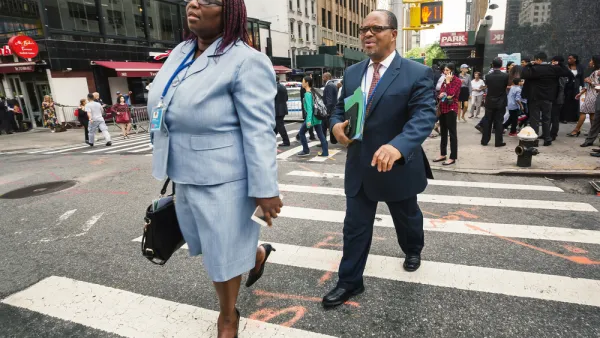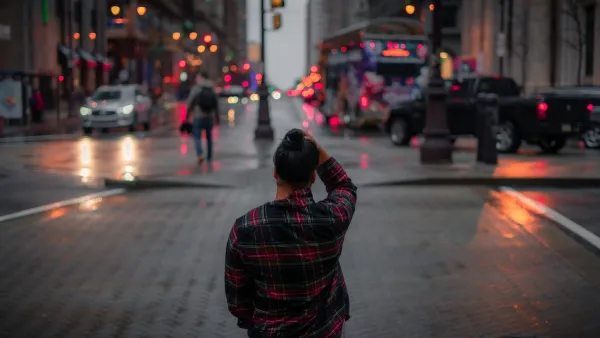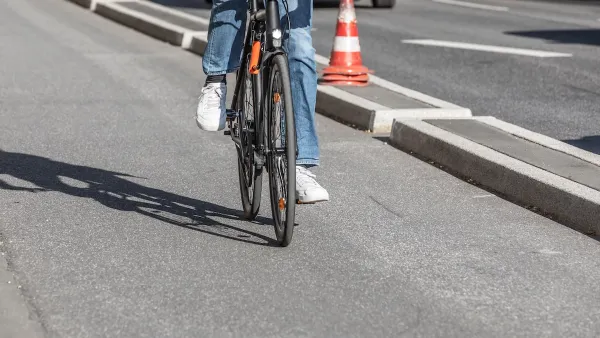Kaid Benfield proposes not only more walkable neighborhoods in the United States, where a pedestrian is struck by a vehicle every 7 minutes, but also more walking to reverse the country's alarming obesity trend.
In Woodbridge, Virginia, U.S. Route 1 looks like just another stretch of road in the country, says Benfield, but "[w]hat you don't see are any but the crudest accommodations for walking." The lack of crosswalks, sidewalks and traffic signals makes this corridor especially dangerous for pedestrians, and those who are hit by drivers are found at fault for "interfering with traffic" under Virginia law. Jay Mallin's Interfering with Traffic documents two men hit by vehicles while trying to cross the road on separate incidents near Route 1. They were charged for interfering with traffic, whereas the drivers were not charged at all. An even worse situation happened in Atlanta in 2011, where a single mother was convicted of homicide after her four-year-old son was killed by a driver under the influence.
"Even if you're not killed or injured, you can't help but find much of suburban American inhospitable to walking," laments Benfield. 13 percent of American children walked to school in 2006, compared to 60 percent in 1973. Laguna Beach refused to participate in International Walk to School Day, and in Montgomery County, Maryland, the local Department of Transportation denied parents' request for a crosswalk because "the safest way is to have them bused to school." Benfield asks, "If walking is no longer safe and convenient in relatively upscale Saratoga Springs and Laguna Beach, how are we going to fix a suburbanizing place whose residents may struggle to afford cars and arguably are even more in need of good alternatives? "
Jeff Speck's Walkable City offers a good start with his "ten steps of walkability" for urban environments, but many areas like the U.S. Route 1 in Woodbridge "are not the kind of prosperous communities where change can occur rapidly and with the degree of investment necessary to do it right." Although an approach still needs to be developed for these places, says Benfield, its imperative that Americans start walking more to reduce obesity and associated risks like heart disease, diabetes and premature death.
FULL STORY: The disturbing and sometimes tragic challenge of walking in America

National Parks Layoffs Will Cause Communities to Lose Billions
Thousands of essential park workers were laid off this week, just before the busy spring break season.

Retro-silient?: America’s First “Eco-burb,” The Woodlands Turns 50
A master-planned community north of Houston offers lessons on green infrastructure and resilient design, but falls short of its founder’s lofty affordability and walkability goals.

Delivering for America Plan Will Downgrade Mail Service in at Least 49.5 Percent of Zip Codes
Republican and Democrat lawmakers criticize the plan for its disproportionate negative impact on rural communities.

Test News Post 1
This is a summary

Test News Headline 46
Test for the image on the front page.

Balancing Bombs and Butterflies: How the National Guard Protects a Rare Species
The National Guard at Fort Indiantown Gap uses GIS technology and land management strategies to balance military training with conservation efforts, ensuring the survival of the rare eastern regal fritillary butterfly.
Urban Design for Planners 1: Software Tools
This six-course series explores essential urban design concepts using open source software and equips planners with the tools they need to participate fully in the urban design process.
Planning for Universal Design
Learn the tools for implementing Universal Design in planning regulations.
EMC Planning Group, Inc.
Planetizen
Planetizen
Mpact (formerly Rail~Volution)
Great Falls Development Authority, Inc.
HUDs Office of Policy Development and Research
NYU Wagner Graduate School of Public Service





























